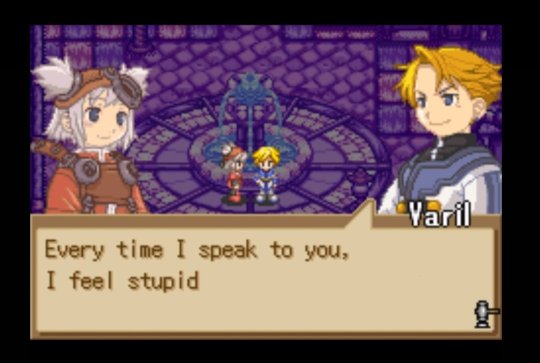

New recovery items exist to regain DP (for weapons), and broken weapons may also be repaired back at your home’s forge. To make things more challenging, however, a weapon’s durability is now a “permanent” gauge like HP, wherein it isn’t recharged after a battle. The “five spells per battle” rule has been bumped up to six, a slot has been added for weapon skills (a whole new concept), and your character is capable of doing a Super Saiyan-like transformation now and then to take care of ugly situations.

The improvements over the original are subtle but significant, particularly in combat. Like the game before it, Summon Night: Swordcraft Story 2 runs on random encounters that go action-RPG like a “Tales” game. The game’s story earns a decent 83%, pretty good for a handheld. The game’s plot and character development are fairly linear, and while the game is longer than its predecessor, characters’ motives are fairly simple much less complex than in the first game, even if you are served a healthy heaping of betrayal from some of your comrades in this one. Now it’s up to you, Edgar/Aera, to keep the world safe. Unfortunately, some folks are plotting to resurrect the beast (named Goura) and use its power to wreak havoc on the world. As is standard procedure, he died in the process. So, as I wrote earlier, your father (Graham) sealed off a big evil summon creature in a temple within the village. All four are wonderful supporters with humorous dialogue to keep the conversations fresh. The four possible summon creatures are Loki, the Oni Child Arno, the Half-Beast Dinah, the Devil Girl (with an angelic split personality) and EXeLD, the Mechanoid Soldier. If you choose male, your name is Edgar, and if female, you are Aera. But most important are the main characters. There is the sibling pair Ryouga and Lynn, who act calm but whose origins are a mystery there’s your adopted family, father Blaire, brother Orin, and sister Tatiana there’s a giant beast named Borgrim and a ghost girl named Nina who sticks with him plus, there are plenty of other NPCs, some annoying villains, and cameos from other Summon Night games (including the real Summon Night 2 for PlayStation). The cast of NPCs are as fun and diverse as they were in the first game. There’s a lot of reading to do, so if you were looking forward to a simple action-RPG, turn back (to the first game in this side-series, preferably). Indeed, the conversations in Swordcraft Story 2 are twice as long and in-depth as that of the first. Nonetheless, a large amount of dialogue was written to keep things fresh for any number of playthroughs, and I congratulate Atlus on taking the time to localize such a small game despite its large script. Some things stick out like a sore thumb for instance, whether male or female, many female NPCs ask for a chance to kiss you. Obviously, with all of the possible combinations of protagonist and sidekick (the number is eight, for those of you who failed all those wordy math problems), a lot of dialogue had to have been written. The similarities continue, as the protagonist (again, gender of your choice) chooses one of four possible summon creatures to be his/her Guardian Beast. Despite the new location and characters, the basic premise is almost entirely the same: start with a character choice (male or female), and learn that said character is the child of a famous Craftknight who saved the village (or perhaps the whole world) from impending doom by sealing off a wicked summon creature. Indeed, there is no mention of Craftlords or Wystern. The second Swordcraft “Story” takes place in a town completely removed from the first, with a completely different setting and premise. One may imagine that the game is “dated,” but it’s surprising to learn just how great a game can be even when it’s two years old. The follow-up to the first Swordcraft Story, Summon Night: Swordcraft Story 2 was released in Japan one year after its predecessor, though the span between the two games’ US release was only a few months.


 0 kommentar(er)
0 kommentar(er)
